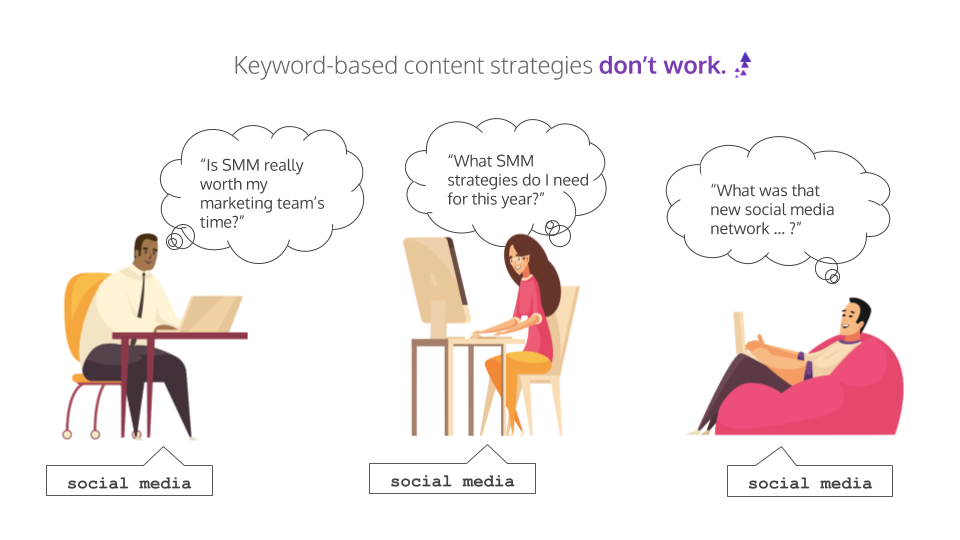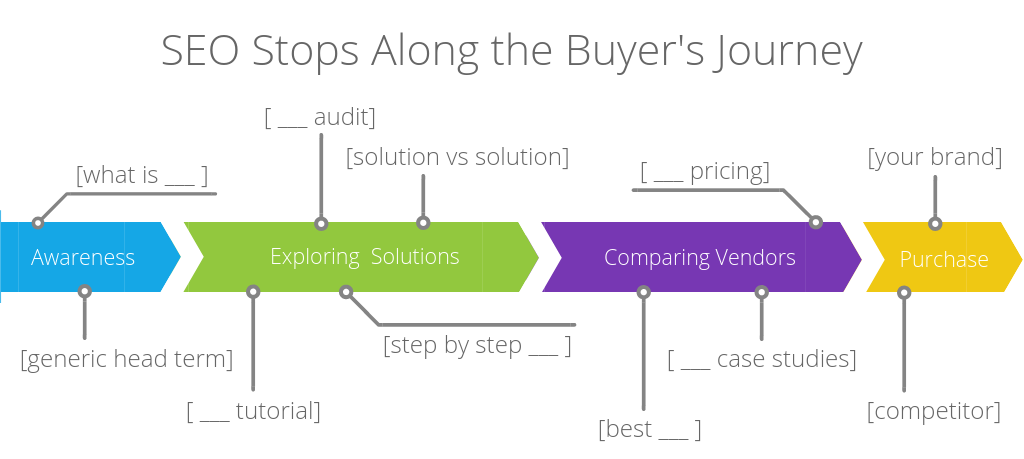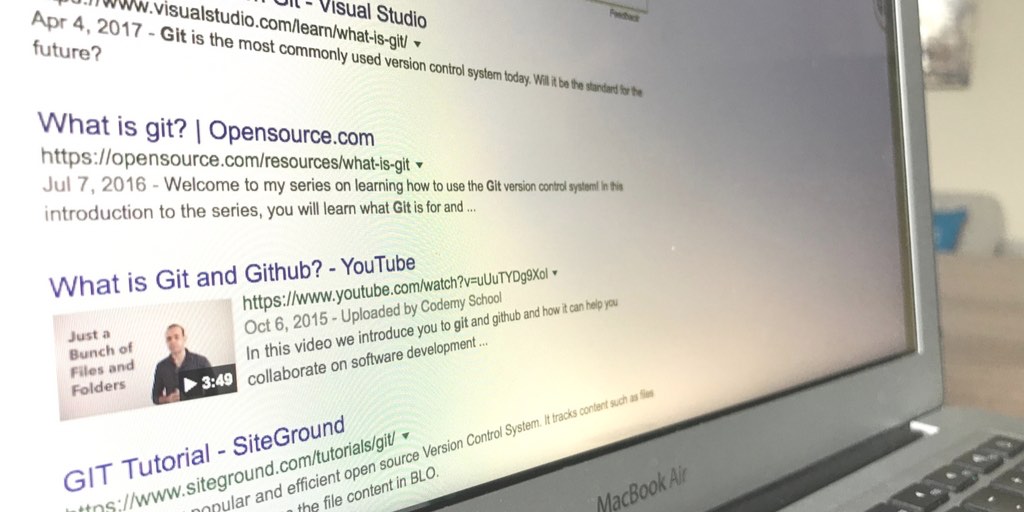Profound’s Framework Uncovers Key Insights that Keyword Lists Alone Will Never Deliver
One unique insight about an audience, industry, or solution can catapult a brand or organization ahead of the competition in so many ways. One “Aha!” moment can inspire a marketing campaign or strategy that connects with buyers in a new, insightful way.
SEO and content marketing is no different.
Key insights about your industry or your audience may seem rare, but they’re around if you know where to look for them. One of the best sources is modern, competitive SEO research, but marketers have to move beyond a basic keyword list to get there.
There are two high-impact insights you’ll never get from a keyword list:
- Insights about content gaps
- Insights about what resonates with your target audience
The only way to get those insights is to go beyond keywords to a modern SEO framework based on user needs.
1. Insights Into Content Gaps
A keyword list is a necessary first step for an SEO content strategy, but it is just that—a first step. After compiling a list of keywords, many marketers focus on the ones they believe are the most important to their business, or the ones they want to rank well for, and begin outlining content ideas.
But keywords alone don’t provide enough information about the amount of content needed, or about content gaps (i.e. necessary content that doesn’t yet exist) that need to be filled.
SEO content strategies based only on keywords leave crucial questions unanswered:
- If there are 200 important keywords, do we really need 200 pieces of content?
- When should we write a single piece of content for a group keywords?
- When do we write two pieces of content for two similar keywords?
- Which keywords will have the most impact/drive the most traffic if we write a piece of content for it?
In order to answer these questions, a marketer must take the next step by learning how to use keywords to identify user needs. A user need is a specific need that a user has, at a specific point in time, that inspires an organic search. A user need will include several related keywords, and it will answer a specific question, or need.
Keyword Ambiguity Means Content Uncertainty
For example, the keyword “social media marketing” may seem like a good topic, but what, exactly, does a user need to know about social media marketing?

How will you know what to write, and how will you know if it has the potential to drive organic traffic? This single keyword could be associated with the following user needs (and more):
- I need a definition of social media marketing.
- I need to learn about the benefits of social media marketing.
- I need to compare social media marketing tools.
- I need to learn about social media marketing for small business.
- I need to know how much social media marketing costs.
- I need to know the average salary for a social media marketing position.
- I need to learn about the difference between social media marketing and PPC advertising.
All of these are very different user needs, each with its own search volume (which will probably be much higher than the search volume for a single keyword). That means that each of these user needs requires a unique piece of content with specific information.
And the keyword “social media marketing” tells us nothing about what specific information should be included, the search volume for a user need, or what “gaps” could be addressed with a new piece of content.
So, a piece of content about “social media marketing” may, or may not, resonate with your target audience unless you target a specific user need.
Gaps in Overall Content Strategy are Addressed
In addition to highlighting content gaps—necessary content that doesn’t exist for a particular user need—this type of SEO research can also expose gaps in a marketer’s overall content strategy.
When a marketer discovers relevant user needs, they can map those user needs to a buyer’s journey for each type of prospective buyer. This allows the marketer to see where he does and does not have content, which will reveal gaps in the overall content strategy.

User needs can be mapped to the buyer’s journey to make sure that your brand is creating SEO content that guides decision-makers all the way through the process.
A marketer may realize, for the first time, that he has lots of bottom-of-funnel content, but almost no top-of-funnel content. Or, he may realize that he has no video content that would really take his educational pieces to the next level. These insights will help him prioritize content creation in the long-term, not just for the immediate piece of content.
By identifying user needs, marketers can move beyond the ambiguity of a keyword list, and get clear about the exact content they should produce in order to generate organic traffic and outrank competitors.
2. Insights About Your Audience
Target audience insights can be discovered by looking at user needs. Marketers who have a relevant user need can examine multiple SERPs for queries that produce similar results, and identify who is winning in the organic space for that conversation. These may include direct competitors, industry publications, Wikipedia, or peripheral players, but these pages are at the top because they are the most helpful content for a given user need.
And these top URLs are a gold mine of information about what resonates with the target audience.
Study what the top content does well. Is the content long or short? Is it educational or sales-related? Does the content include images? Tables? Video? Is the content evergreen or timely? What are some common subtopics? Are there common phrases throughout? Does it seem to address the executive or the practitioner?

After considering these points and more, what can you infer about your target audience? What kind of information do they find helpful?
This new information should provide insights about the market and guidance for how to structure new content.
Next, take what you’ve learned from the top-performing content and figure out how to use your brand’s unique voice, positioning, and insights to make the information even more helpful and engaging than the content produced by competitors.
Three Audience Insight Case Studies
Profound Strategy editors put these kinds of unique audience insights to work for our clients every day. Our team spends a lot of time studying SERP and organic content, and we’re still sometimes surprised by what we find!
1. The audience that wanted to find files
One of our partners asked for a strategy that would get their brand noticed in organic search for “IIS logs” topics. Usually, head terms such as “IIS logs” reveal a user need like, “I need a definition of IIS logs” and a featured snippet that defines the term. But not this time!
The most common user need for this, and related, keywords was, “I need to find my IIS log files.” Rather than creating, “What are IIS log files?” content, we helped the client create detailed, step-by-step instructions for finding IIS log files. That content moved to the top of organic search results, and snagged the featured snippet spot, within six months!
2. The audience that wanted information
Another brand came to Profound for help breaking into conversations about workforce management. Our research uncovered a variety of user needs related to purchase and learn intents, and that most competitors were ignoring the later.
In order to stand out from the competition, and fill a content gap, we worked with the client to create an SEO content strategy based on informative user needs. Months after publication started, the client was at the top of SERPs, and in at least one featured snippet for high-priority, informative user needs.

3. The audience that was ready for a different perspective
A long-term client enlisted Profound’s help as they expanded their business. They had a new need to be in front of organic audiences for “on call schedule” topics.
The problem, however, was that organic results were dominated by product pages and healthcare brands (which this organization is not).
Our team’s research revealed two key insights about this space, though: (1) most of the top content used a negative tone, and (2) there were two audiences being addressed by different content assets.
Based on those insights, we outlined a thought-leadership piece that addressed both audiences and used a different, more positive tone. The content was on Google’s page one—even in an industry new to this brand—in less than six months.
SEO Insights that Get to Growth
An insight isn’t a curiosity; an insight is something that helps create real, measurable results in business. And lots of companies are trying to figure out SEO, but many of them still waste time and effort on old-school tactics and content that’s just okay.
Profound Strategy uses a modern SEO framework, based on user needs and high-impact insights, to produce certified content that not only moves the needle on SEO for our clients—but also provides unique, competitive insights into their industries and target audiences! That’s how we routinely create content that generates organic traffic and helps them outrank competitors.
Want to learn more about how Profound Strategy can help you craft SEO-certified content that can stand the test of time? Contact us to speak with one of our SEO strategists today.
What's Next?
Profound Strategy is on a mission to help growth-minded marketers turn SEO back into a source of predictable, reliable, scalable business results.
Start winning in organic search and turn SEO into your most efficient marketing channel. Subscribe to updates and join the 6,000+ marketing executives and founders that are changing the way they do SEO:
And dig deeper with some of our best content, such as The CMO’s Guide to Modern SEO, Technical SEO: A Decision Maker’s Guide, and A Modern Framework for SEO Work that Matters.




